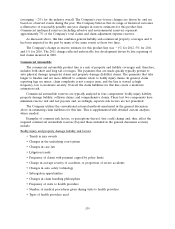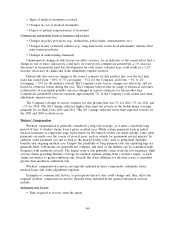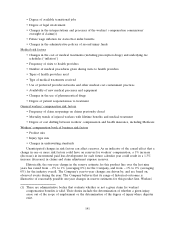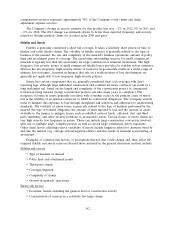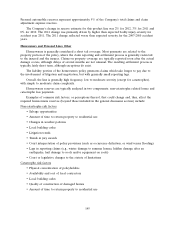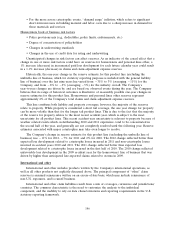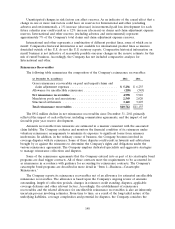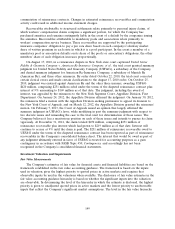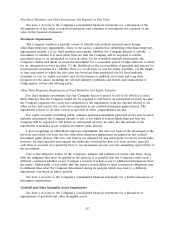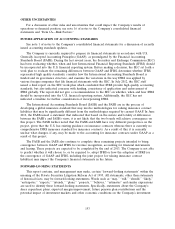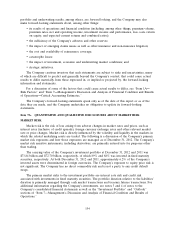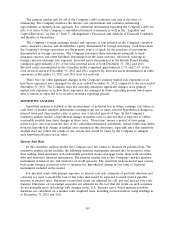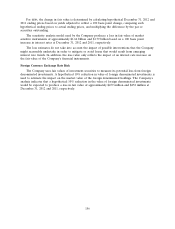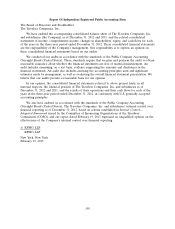Travelers 2012 Annual Report Download - page 161
Download and view the complete annual report
Please find page 161 of the 2012 Travelers annual report below. You can navigate through the pages in the report by either clicking on the pages listed below, or by using the keyword search tool below to find specific information within the annual report.commutation of reinsurance contracts. Changes in estimated reinsurance recoverables and commutation
activity could result in additional income statement charges.
Recoverables attributable to structured settlements relate primarily to personal injury claims, of
which workers’ compensation claims comprise a significant portion, for which the Company has
purchased annuities and remains contingently liable in the event of a default by the companies issuing
the annuities. Recoverables attributable to mandatory pools and associations relate primarily to
workers’ compensation service business. These recoverables are supported by the participating
insurance companies’ obligation to pay a pro rata share based on each company’s voluntary market
share of written premium in each state in which it is a pool participant. In the event a member of a
mandatory pool or association defaults on its share of the pool’s or association’s obligations, the other
members’ share of such obligation increases proportionally.
On August 17, 2010, in a reinsurance dispute in New York state court captioned United States
Fidelity & Guaranty Company v. American Re-Insurance Company, et al., the trial court granted summary
judgment for United States Fidelity and Guaranty Company (USF&G), a subsidiary of the Company,
and denied summary judgment for American Re-Insurance Company, a subsidiary of Munich Re
(American Re), and three other reinsurers. By order dated October 22, 2010, the trial court corrected
certain clerical errors and made certain clarifications to the August 17, 2010 order. On October 25,
2010, judgment was entered against American Re and the other three insurers, awarding USF&G
$420 million, comprising $251 million ceded under the terms of the disputed reinsurance contract plus
interest of 9% amounting to $169 million as of that date. The judgment, including the award of
interest, was appealed by the reinsurers to the New York Supreme Court, Appellate Division, First
Department. On January 24, 2012, the Appellate Division affirmed the judgment. On January 30, 2012,
the reinsurers filed a motion with the Appellate Division seeking permission to appeal its decision to
the New York Court of Appeals, and on March 12, 2012, the Appellate Division granted the reinsurers’
motion. On February 7, 2013, the Court of Appeals issued an opinion that largely affirmed the
summary judgment in USF&G’s favor, while modifying in part the summary judgment with respect to
two discrete issues and remanding the case to the trial court for determination of those issues. The
Company believes it has a meritorious position on each of these issues and intends to pursue its claim
vigorously. At December 31, 2012, the claim totaled $470 million, comprising $251 million of
reinsurance recoverable plus interest which had grown to $219 million as of that date. Interest will
continue to accrue at 9% until the claim is paid. The $251 million of reinsurance recoverable owed to
USF&G under the terms of the disputed reinsurance contract has been reported as part of reinsurance
recoverables in the Company’s consolidated balance sheet. The interest that would be owed as part of
any judgment ultimately entered in favor of USF&G is treated for accounting purposes as a gain
contingency in accordance with FASB Topic 450, Contingencies, and accordingly has not been
recognized in the Company’s consolidated financial statements.
Investment Valuation and Impairments
Fair Value Measurements
The Company’s estimates of fair value for financial assets and financial liabilities are based on the
framework established in the fair value accounting guidance. The framework is based on the inputs
used in valuation, gives the highest priority to quoted prices in active markets and requires that
observable inputs be used in the valuations when available. The disclosure of fair value estimates in the
fair value accounting guidance hierarchy is based on whether the significant inputs into the valuation
are observable. In determining the level of the hierarchy in which the estimate is disclosed, the highest
priority is given to unadjusted quoted prices in active markets and the lowest priority to unobservable
inputs that reflect the Company’s significant market assumptions. The level in the fair value hierarchy
149


